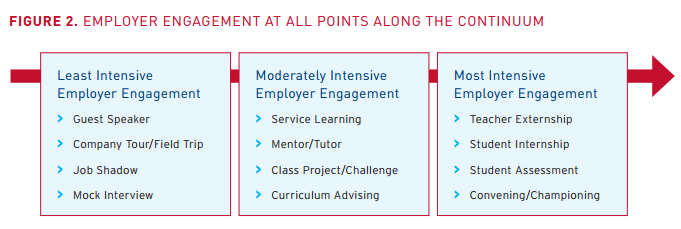Jobs for the Future’s Pathways to Prosperity Network recently released a toolkit to help demystify work-based learning for employers. In the report, “Not as Hard as You Think: Engaging High School Students in Work-based Learning,†JFF acknowledges that addressing employers’ concerns about liability and labor law issues are critical to scaling up work-based learning (WBL) opportunities.
The brief’s primary goal is to alleviate employers’ concerns about perceived barriers to allowing high school students into the workplace, and also offers three case studies of employers in manufacturing and health care that have successfully launched such experiential opportunities.
First, the report offers the greatest benefits of WBL for employers:
- Developing a more robust talent pipeline
- Gaining access to a diverse and innovative workforce
- Creating opportunities to increase name recognition and positive press
- Encouraging economic growth that in turn boosts business prospects
To create these opportunities, most employers need “to make only minimal changes, if any, to existing workplace policies and procedures in order to ensure compliance with state and federal laws and policies,†according to the report. The greatest restriction for youth under 18 is the 17 hazardous occupations identified by the U.S. Department of Labor, but just one of these occupations – operating a forklift — is actually in use in most workplaces, the report states. Within the manufacturing industry, most federal restrictions apply only to 14- and 15-year-olds. Other restrictions regarding work hours, minimum wages, permits and required rest or meal periods are typically a matter of state law.
Employers’ insurance policies are a more likely source of barriers to the workplace than state or federal regulations. Yet, the report found that liability issues for paid student interns are often covered under existing workers’ compensation policies. Some employers have been able to work with their insurers to clarify and address WBL restrictions and others take additional steps to limit their liability by having students and families sign liability waivers and working with intermediary organizations.
The report offered three ways to encourage and support employers’ WBL efforts:
- Incentivize employer engagement through tax credits, subsidies, etc.
- Embed WBL in curriculum through teacher externships and credit for WBL
- Support intermediaries that can broker WBL opportunities and be a resource to schools and employers
Credentials for All
The Southern Regional Education Board’s Commission on Career and Technical Education released its final report earlier this month, and described the bridge from high school to postsecondary and the workforce as broken and in desperate need of fixing.
To repair this bridge, the Commission offers eight actions that states can take to reach the goal of doubling the number of young people completing some form of a college credential by the age of 25. Be sure to check out the full report for all eight action steps.
Andrea Zimmermann, State Policy Associate
Tags: credentials, employers, Jobs for the Future, SREB, work-based learning


